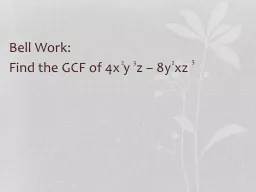

Find the GCF of 4x y z 8y xz 2 3 2 3 Answer 4xy z 2 Lesson 35 Factoring the gCF Cancelling When we use the distributive property we change an expression from a product to a sum The expression 2ax c tells us to multiply 2a by x c if we do this multiplication we get ID: 233323
Download Presentation The PPT/PDF document "Bell Work:" is the property of its rightful owner. Permission is granted to download and print the materials on this web site for personal, non-commercial use only, and to display it on your personal computer provided you do not modify the materials and that you retain all copyright notices contained in the materials. By downloading content from our website, you accept the terms of this agreement.
Slide1
Bell Work:Find the GCF of 4x y z – 8y xz
2
3
2
3Slide2
Answer:4xy z
2Slide3
Lesson 35: Factoring the gCF, Cancelling Slide4
When we use the distributive property, we change an expression from a product to a sum. The expression 2a(x + c) tells us to multiply 2a by x + c. if we do this multiplication, we get the algebraic sum 2ax + 2ac. 2a(x + c) = 2ax + 2acSlide5
If we reverse the process and write 2ax + 2ac as the product of the two factors 2a and (x + c), we say that we are factoring. Slide6
Factoring is the process of writing an indicated sum as a product of factors. Slide7
Example:Factor the greatest common factor of
2ax + 2acWe will factor in 3 steps. First, write two empty parentheses to indicate a product.
( )( )Second, write the GCF in the first set of parentheses. (2a)( )
Third, write the proper terms in the second parentheses so that 2a times these terms gives us 2ax + 2ac. (2a)(x + c)Slide8
Example:Factor the greatest common factor of
a x m + a xm – a x m
3
2
2
2
3
4
3
2Slide9
Answer:(a xm )(ax + m – a x )
2
2
2
2Slide10
Practice:Factor 4a b z + 2a bz
3
4
3
2
4Slide11
Answer:2a bz (2ab + z)
2
3
3Slide12
Practice:Factor the greatest common factor of 6a x + 2a x + 4a x
2
2
3
3
4
3Slide13
Answer:2a x (3 + ax + 2a x)
2
2
2Slide14
Canceling: we have been solving equations by using the fact that multiplication and division are inverse operations because they “undo” one another. Slide15
If we want to solve the equation 4x = 20
We see that x is multiplied by 4. To undo multiplication by 4, we must divide by 4. if we divide one side of an equation by 4, we must also divide the other side of the equation by 4.
4x = 20
4 4 x = 5Slide16
On the left, we say that we have canceled the 4s. Some people prefer to say that 4 over 4 is “reduced to 1” instead of saying “canceled”. Slide17
The 4s cannot be canceled in this expression because addition and division are not inverse operations and do not undo one another. x + 4
= x + 1 4Slide18
The following expression can be simplified by canceling because multiplying by 4 and division by 4 undo each other. We can see that 4 over 4 “reduces to 1”.
4(x + 1) = x + 1 4Slide19
Cancellation or reduction to 1 is possible when the numerator and the denominator contain one or more common factors. In the expression previously discussed, we remember that the 4 in the denominator can be written as 4 x 1. Thus, both the numerator and denominator have 4 as a factor.Slide20
Practice:Simplify 5(a – 3)
5Slide21
Answer:a – 3 Slide22
Practice:Simplify 3(x – 2)
x – 2 Slide23
Answer:3Slide24
Practice:Simplify 3p + 3
3Slide25
Answer:3p + 3 3
= 3(p + 1) 3
= p + 1Slide26
Practice:Simplify 3x – 9x
3x
2Slide27
Answer:3x(1 – 3x) 3x
= 1 – 3x Slide28
HW: Lesson 35 #1-30Due tomorrow